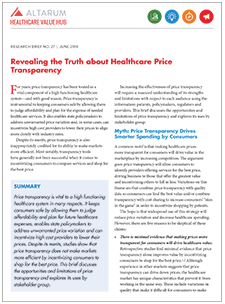Improving Value
Patient Engagement and Patient Activation
Though they sound similar, patient activation and patient engagement are different, but overlapping, concepts.1
Patient Activation:
- Understanding one's own role in the care process
- Having the knowledge, skills, confidence and willingness to take on that role and manage their healthcare and health outcomes
Patient Engagement: A broader concept, including Patient Activation, but also...
- The interventions designed to increase it
- The patient behavior that results from it
It is important to note that patient engagement is not synonymous with compliance. Compliance means an individual obeys a directive from a healthcare provider.
There is strong evidence that patients who are more actively involved in their healthcare experience better outcomes, as well as limited evidence that they incur lower costs.2
Yet, patient activation rarely happens automatically. A 2008 study found that the level of patient activation varies considerably in the U.S. population.3 The study found that activation levels are especially low for people with low incomes, less education, Medicaid enrollees and people with poor self-reported health.
The healthcare system in the United States is very complex and patients often struggle to obtain, communicate and understand health information and services. Providers often fail to provide adequate information patients need to make the best decisions about their care and treatment options. Additionally, patients can be overwhelmed or lack confidence in their own choices. Many of the behaviors we ask of patients are only done by those in the highest level of activation.
What Works?
Providers should use the patient's activation level to fine-tune patient engagement.
We need to move away from simply "telling patients what to do." Moreover, when we focus on the more complex and difficult behaviors, we discourage the least activated patients.
Tailor approches and focus on developing patient confidence and skills, and not just the transfer of information. Start with behavior more feasible for patients to take on, increasing individual's opportunity to experience success.
- Patients who are disengaged and overwhelmed may need more frequent and deeper outreach (including personal outreach by nurses or others), whereas
- Patients demonstrating greater engagement may require less frequent and simpler interactions (such as emails or auto-calls).
Successful patient engagement requires us to recognize that physicians frequently do not understand patient goals and preferences, and patients are often under-informed about basic facts relative to their condition and treatment options. Evidence shows that there are enormous gaps between what patients want and what doctors think they want. For example, a physician may believe that a patient with prostate cancer's priority is to remove the cancer, while the patient's priority may, in fact, be to maintain the best possible quality of life. The misdiagnosis of patient preferences is a key barrier to delivering better healthcare value.
Two techniques with strong supporting evidence include:4
- Shared decision making, which helps patients understand what the reasonable options are, then eliits, informs and integrates patients' informed preferences as they relate to the available options. Strong evidence shows that shared decision making can benefit both provider and patient, improving outcomes, treatment decisions and patient-physician satisfaction.
- Motivational interviewing - a patient-centered approach to counseling for guiding behavior change, usually when a patient feels ambivalent, e.g. about lifestyle choices or adherence to medication. Clinicians guide patients through the process of setting goals and recognizing the importance of wellness. Clinicians do not preach to the patient, but rather engage in a two-way conversation surrounding goal-setting.
Interventions, such as shared-decision making tools, can lead patients to seek a more active role in their treatment and feel confident that they can contribute to discussions about their medical care.
Notes
1. Shortell, Stephen, "Patient Engagement, Activation & The ACO: An Early Assessment," Center for Healthcare Organizational Innovation Research at UC Berkely (December 4, 2015).
2. Greene, Jessica and Judith Hibbard, "Why Does Patient Activation Matter? An Examination of the Relationships Between Patient Activation and Health-Related Outcomes," Journal of General Intern Medicine, Vol. 25, No. 5 (May 2012); After controlling for demographics and health status, 31% cost differential between highly activated patients and those low in activation. See also: Greene, Jessica, et al., "When Patient Activation Levels Change, Health Outcomes And Costs Change, Too," Health Afairs, Vol. 34, No. 3 (March 2015); Wardian, Jana, et al., "Patient Commitment and Its Relationship to A1C," Clinical Diabetes, Vol. 36, No. 4 (October 2018).
3. Hibbard, Judith, and Peter Cunningham, "How Engaged Are Consumers in Their health and Health Care, and Why Does It Matter," Center for Studying Health System Change, Research Brief No. 8 (October 2008).
4. Elwyn, Glyn, et al., "Shared Decision Making and Motivational Interviewing: Achieving Patient-Centered Care Across the Spectrum of Health Care Problems," Annals of Family Medicine, Vol. 12, No. 3 (May 2014).







